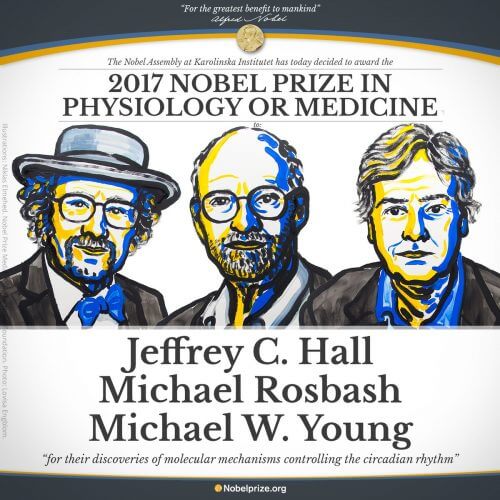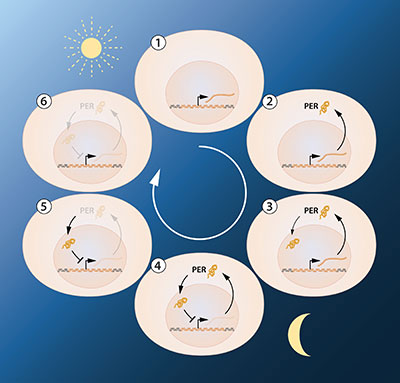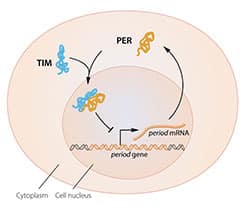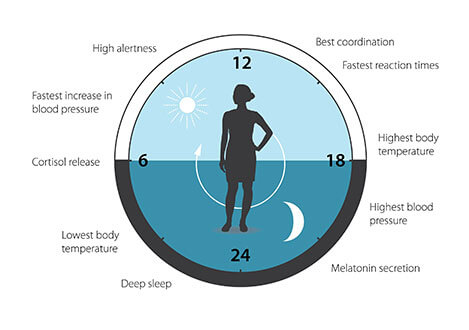Using fruit flies as a model, the researchers isolated a gene that controls the normal daily biological rhythm. They showed that this gene encodes a protein that accumulates in cells during the night, and then breaks down during the day. Following this, they discovered additional protein components that make up this system, revealing the mechanism that controls the biological clock within the cells themselves

Jeffrey C. Hall, Michael Rosbash and Michael Young for the discovery of the molecular mechanisms underlying the circadian rhythm, a rhythm that operates in approximately 24-hour cycles and is designed to adjust the creature's activity to the changing influence of the sun throughout the day. This rhythm determines the central biological clock of the organism.
Life on Earth is adapted to the rotation of our planet. It has been known for many years that living beings, including humans, contain an internal biological clock that helps them predict and adjust themselves to the normal rhythm of the day. But how exactly does this watch work? The three Nobel laureates for this year were able to peer into our biological clock and understand its internal components. Their discoveries explain how plants, animals and humans adjust their biological rhythm so that it is synchronized with the rotation of the Earth on its axis.
Using fruit flies as a model, the researchers isolated a gene that controls the normal daily biological rhythm. They showed that this gene encodes a protein that accumulates in cells during the night, and breaks down during the day. Following this, they discovered additional protein components that make up this system, revealing the mechanism that controls the biological clock within the cells themselves.
Our internal clock, with the highest level of accuracy, adjusts our physiology to the frequently changing phases of the day. This clock regulates vital functions such as our behavior, hormone levels in the body, sleep, body temperature and metabolism. Our physical well-being is affected when there is a temporary imbalance between our external environment and our internal biological clock, for example - when we cross several time zones and experience jet lag. There are also hints that a chronic imbalance between our lifestyle and the rhythm dictated by our internal clock is associated with an increased risk of the onset of a variety of diseases.

Our internal clock
Most living things expect and adapt to the daily changes in the environment. During the eighteenth century, the astronomer Jean Jacques d'Ortous de Mairan studied the mimosa plant and found that the plant spreads its leaves towards the sun during the day and folds them during the dark. He wondered what would happen to the plant if it were in a constant state of darkness. He discovered that regardless of the daily sunlight the leaves continued to jump between their unfolded state and their folded state, as they were used to from the moment of their creation (Figure 1). Plants seem to have their own biological clock.
Other researchers discovered that not only plants, but also animals and even humans, have a biological clock that helps them adjust their physiology following the changes that occur during the hours of the day. This regular adjustment is known as the 'circadian rhythm' which comes from the Latin words circa which means 'around' and from the Latin word dies which means 'day'. However, how exactly our internal biological clock works remains a mystery.
Discovery of the gene responsible for clock activity
During the XNUMXs, researcher Seymour Benzer and his student Ronald Konopka wondered if it was possible to identify genes responsible for the circadian rhythm in fruit flies. They demonstrated that introducing mutations into an unidentified gene caused a disruption in the biological clock of the flies. They named this gene 'cycles'. However, they still did not understand how this gene affects the daily rhythm.

The 2017 Nobel Prize winners, who also studied fruit flies, focused on discovering the mechanism of the biological clock's activity. In 1984, the two researchers Jeffrey Hall and Michael Rosbash, working closely at Boston University, along with Michael Young, at New York University, were able to isolate and identify the gene. In the next step, the two researchers Jeffrey Hall and Michael Rosbash were able to discover the protein encoded by this gene, the PER protein. It turns out that this protein accumulates during the night and breaks down during the day. In other words, PER protein levels rise and fall in a 24-hour deficiency, in full synchronization with the circadian rhythm.
A clock mechanism that regulates itself independently
The next goal in the research was to understand how these circadian fluctuations are received and disappear. Researchers Jeffrey Hall and Michael Rosbash hypothesized that the PER protein blocks the activity of the cycle gene. They theorized that through an inhibition-type feedback loop, the EPR protein could prevent its own synthesis and therefore self-regulate protein levels in a circular, continuous rhythm (Figure 2A).
This model was tempting, but there were still several pieces missing from the attachment. In order to block the activity of the cycle gene, the PER protein, which is created in the cytoplasm, needs to reach the cell nucleus, where the genetic material is located. The two researchers showed that the protein accumulates during the night in the cell nucleus, but they could not explain how it gets there. In 1994, the researcher Michael Young discovered another gene responsible for the biological clock, which he named 'timeless', which encodes a protein called TIM which is required for the existence of a normal circadian rhythm. During a very elegant experiment, researcher Michael Young showed that when the two proteins (TIM+PER) bind together, they are able to enter the cell nucleus where they block the activity of the cycle gene and initiate the feedback loop (Figure 2B).
Figure 2B The PER protein, which is responsible for inhibiting the gene that encodes it, manages to enter the cell nucleus only when it is attached to the second protein, the TIM protein.

Such a feedback mechanism indeed succeeds in explaining the fluctuations in the protein levels in the cell, but several questions still remain. What controls the frequency of oscillations? Michael Young identified another gene, a gene called doubletime, which encodes the DBT protein that causes a delay in the accumulation rate of the PER protein in the cell nucleus. This discovery provides the insights needed to understand how the fluctuations correspond almost exactly to the 24-hour cycle.
The innovative discoveries of the 2017 Nobel Laureates in Physiology gave birth to main mechanistic principles that are at the base of the biological clock. During the following years, additional components of this mechanism were discovered, components that deepened the understanding of the stability and robustness of this mechanism. For example, the Nobel laureates identified additional proteins required for the activation of the cycle gene, as well as proteins with the help of which light can synchronize the clock.
Observing human physiology
The biological clock is involved in many aspects of our complex physiology. Today we know that all multicellular creatures, including humans, use the same mechanism to control the circadian rhythm. A large number of our genes are regulated by the biological clock, and consequently, a strictly calibrated circadian rhythm adjusts our physiology to the different phases during the day (Figure 3). Since the discoveries of the three Nobel laureates, the field of circadian biology has developed into a vast and extremely dynamic field of research, with implications for human health and personal well-being.


4 תגובות
circadian I will fix it
I didn't understand, so is it cycad or cycad? Power once is written differently!
Should it be circadian at all?
Jonathan, the mistake was not Dr. Moshe Nachmani's but mine in uploading the article.
Very interesting article. I just want to correct that the text:
"Such a feedback mechanism does manage to explain the fluctuations in protein levels in the cell, but several questions still remain. What controls the frequency of oscillations? Michael Young identified another gene, a gene called doubletime, which encodes the DBT protein that causes a delay in the accumulation rate of the PER protein in the cell nucleus. This discovery provides the insights needed to understand how the fluctuations correspond almost exactly to the 24-hour cycle."
You wrote twice one after the other :).
In addition, it is interesting if our body is able to adapt to a time other than our standard 24 hours and how we will react to that.